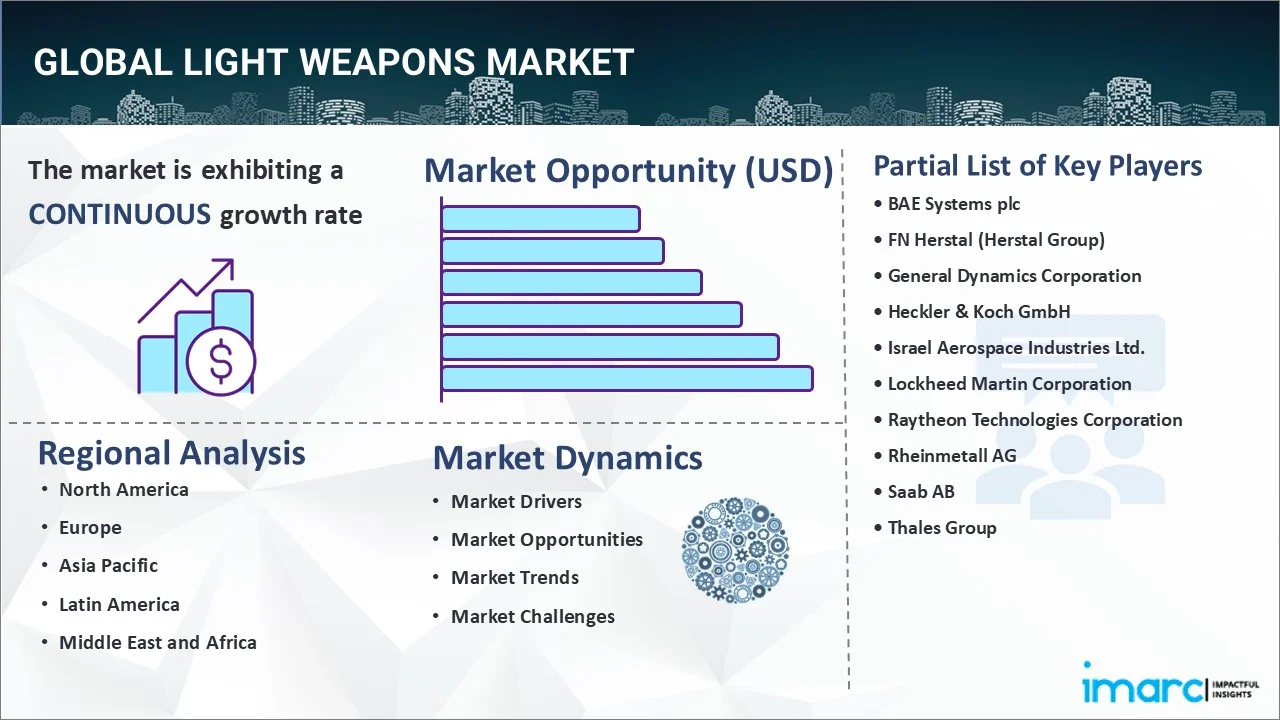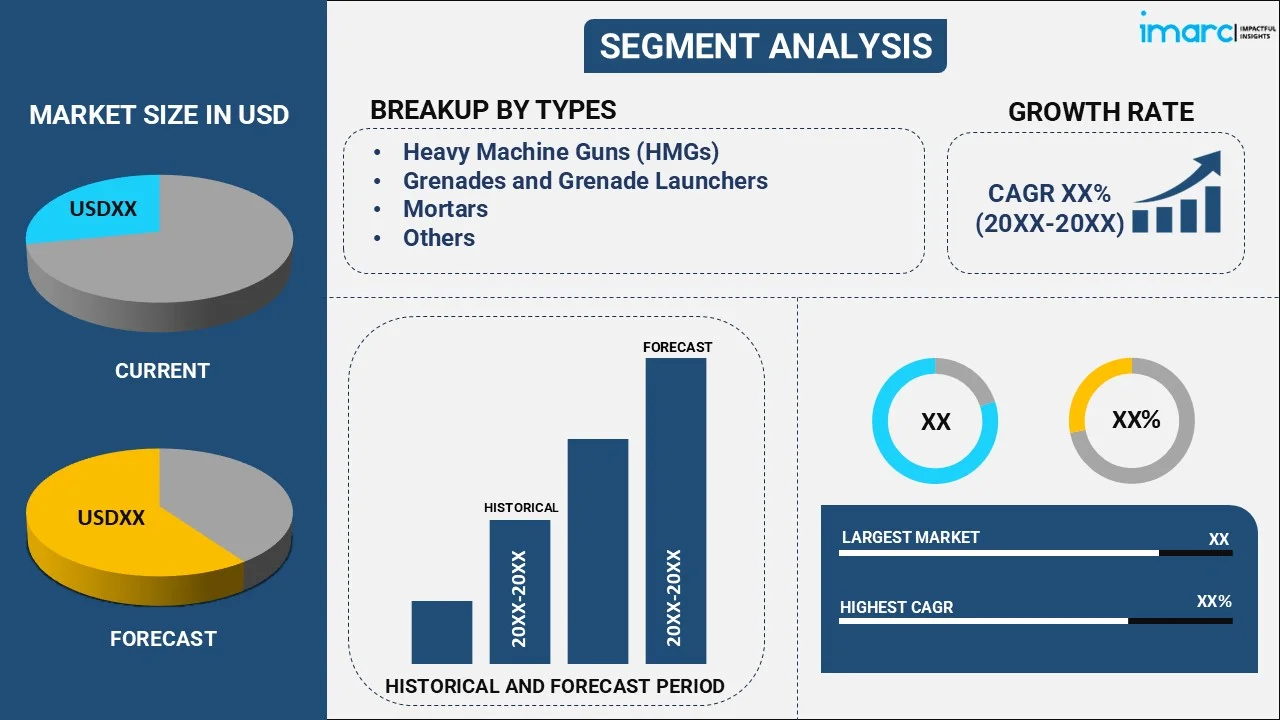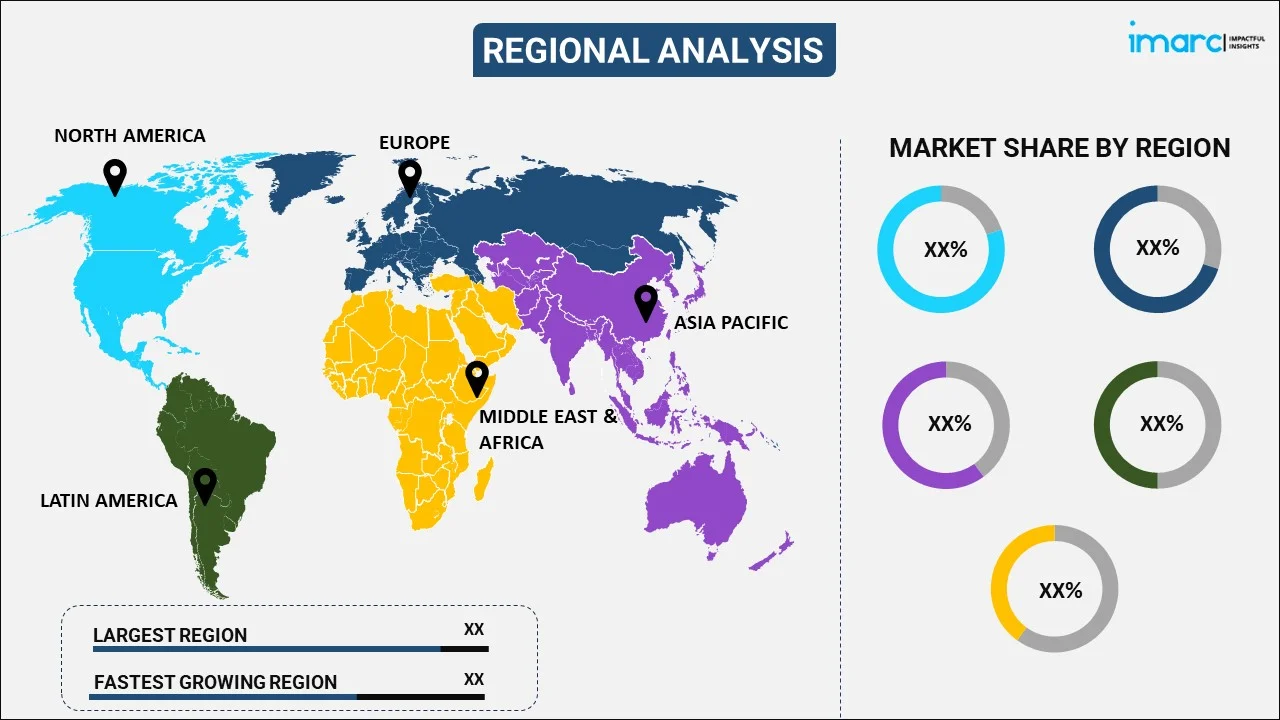
Light Weapons Market Report by Type (Heavy Machine Guns (HMGs), Grenades and Grenade Launchers, Mortars, Man-portable Anti-tank Systems (MANPATS), Man-portable Air Defense Systems (MANPADS), and Others), Technology (Guided, Unguided), Application (Defense, Homeland Security), and Region 2025-2033
Market Overview:
The global light weapons market size reached USD 14.4 Billion in 2024. Looking forward, IMARC Group expects the market to reach USD 21.2 Billion by 2033, exhibiting a growth rate (CAGR) of 4.19% during 2025-2033.
|
Report Attribute
|
Key Statistics
|
|---|---|
|
Base Year
|
2024
|
|
Forecast Years
|
2025-2033
|
|
Historical Years
|
2019-2024
|
|
Market Size in 2024
|
USD 14.4 Billion |
|
Market Forecast in 2033
|
USD 21.2 Billion |
| Market Growth Rate 2025-2033 | 4.19% |
Light weapons refer to a group of weapons that are designed to be used by more than one crew member but can also be used by one individual under certain conditions. They are predominantly used by defense forces in combat missions and naval operations. It comprises heavy machine guns, mounted grenade launchers, MANPADS (man-portable anti-defense systems), recoilless rifles, anti-tank missile launchers, anti-tank guns, landmines, mortars of lesser caliber, and anti-aircraft missiles. Technologies for guided weapons as well as unguided weapons are used in the production of these weapons. Some of the common materials used in the manufacturing of these weapons include steel and polymers. Defense and homeland security are two of the major applications of light weapons.

Light Weapons Market Trends:
The market is primarily driven by significant growth in the military and defense sector due to the escalating demand for advanced weapons. This can be attributed to the increasing adoption of precision-guided firearms with advanced features, such as targeting, fire control, and advanced head-up display technologies. An increasing number of contracts for light weapons from military forces and homeland security are also providing a boost to the market. Moreover, extensive research and development (R&D) activities conducted by key weapon manufacturers are creating a positive market outlook. The market is also propelled by continual technological advancements in weapon manufacturing, such as the advent of an increased range of anti-tank missiles, integration of laser systems in light cannons, and incorporation of artificial intelligence (AI) features. A considerable increase in terrorism, cross-border disputes, and political unrest between neighboring countries are further contributing to a significant rise in the uptake of light weapons. Some of the other factors contributing to the market include the low production cost of the product, the expanding military modernization programs, and the rising defense expenditure.
Key Market Segmentation:
IMARC Group provides an analysis of the key trends in each sub-segment of the global light weapons market report, along with forecasts at the global, regional and country level from 2025-2033. Our report has categorized the market based on type, technology and application.
Breakup by Type:

- Heavy Machine Guns (HMGs)
- Grenades and Grenade Launchers
- Mortars
- Man-portable Anti-tank Systems (MANPATS)
- Man-portable Air Defense Systems (MANPADS)
- Others
Breakup by Technology:
- Guided
- Laser Guided
- Infrared Guided
- Satellite Guided
- Semi-automatic Command to Line of Sight
- Unguided
Breakup by Application:
- Defense
- Homeland Security
Breakup by Region:

- North America
- United States
- Canada
- Asia-Pacific
- China
- Japan
- India
- South Korea
- Australia
- Indonesia
- Others
- Europe
- Germany
- France
- United Kingdom
- Italy
- Spain
- Russia
- Others
- Latin America
- Brazil
- Mexico
- Others
- Middle East and Africa
Competitive Landscape:
The competitive landscape of the industry has also been examined along with the profiles of the key players being BAE Systems plc, FN Herstal (Herstal Group), General Dynamics Corporation, Heckler & Koch GmbH, Israel Aerospace Industries Ltd., Lockheed Martin Corporation, Raytheon Technologies Corporation, Rheinmetall AG, Saab AB and Thales Group.
Report Coverage:
| Report Features | Details |
|---|---|
| Base Year of the Analysis | 2024 |
| Historical Period | 2019-2024 |
| Forecast Period | 2025-2033 |
| Units | Billion USD |
| Segment Coverage | Type, Technology, Application, Region |
| Region Covered | Asia Pacific, Europe, North America, Latin America, Middle East and Africa |
| Countries Covered | United States, Canada, Germany, France, United Kingdom, Italy, Spain, Russia, China, Japan, India, South Korea, Australia, Indonesia, Brazil, Mexico |
| Companies Covered | BAE Systems plc, FN Herstal (Herstal Group), General Dynamics Corporation, Heckler & Koch GmbH, Israel Aerospace Industries Ltd., Lockheed Martin Corporation, Raytheon Technologies Corporation, Rheinmetall AG, Saab AB and Thales Group. |
| Customization Scope | 10% Free Customization |
| Post-Sale Analyst Support | 10-12 Weeks |
| Delivery Format | PDF and Excel through Email (We can also provide the editable version of the report in PPT/Word format on special request) |
Key Questions Answered in This Report
The light weapons market was valued at USD 14.4 Billion in 2024.
We expect the global light weapons market to exhibit a CAGR of 4.19% during 2025-2033.
The increasing rate of terrorism and cross-border disputes, along with the rising adoption of precision-guided firearms with advanced features, such as targeting, fire control, head-up display technologies, etc., is primarily driving the global light weapons market.
The sudden outbreak of the COVID-19 pandemic had led to the implementation of stringent lockdown regulations across several nations, resulting in the temporary closure of numerous manufacturing units for light weapons.
Based on the technology, the global light weapons market has been segregated into guided and unguided, where guided currently holds the largest market share.
Based on the application, the global light weapons market can be bifurcated into defense and homeland security. Currently, defense exhibits a clear dominance in the market.
On a regional level, the market has been classified into North America, Asia-Pacific, Europe, Latin America, and Middle East and Africa, where North America currently dominates the global market.
Some of the major players in the global light weapons market include BAE Systems plc, FN Herstal (Herstal Group), General Dynamics Corporation, Heckler & Koch GmbH, Israel Aerospace Industries Ltd., Lockheed Martin Corporation, Raytheon Technologies Corporation, Rheinmetall AG, Saab AB, and Thales Group.
Need more help?
- Speak to our experienced analysts for insights on the current market scenarios.
- Include additional segments and countries to customize the report as per your requirement.
- Gain an unparalleled competitive advantage in your domain by understanding how to utilize the report and positively impacting your operations and revenue.
- For further assistance, please connect with our analysts.
 Inquire Before Buying
Inquire Before Buying
 Speak to an Analyst
Speak to an Analyst
 Request Brochure
Request Brochure
 Request Customization
Request Customization




.webp)




.webp)












